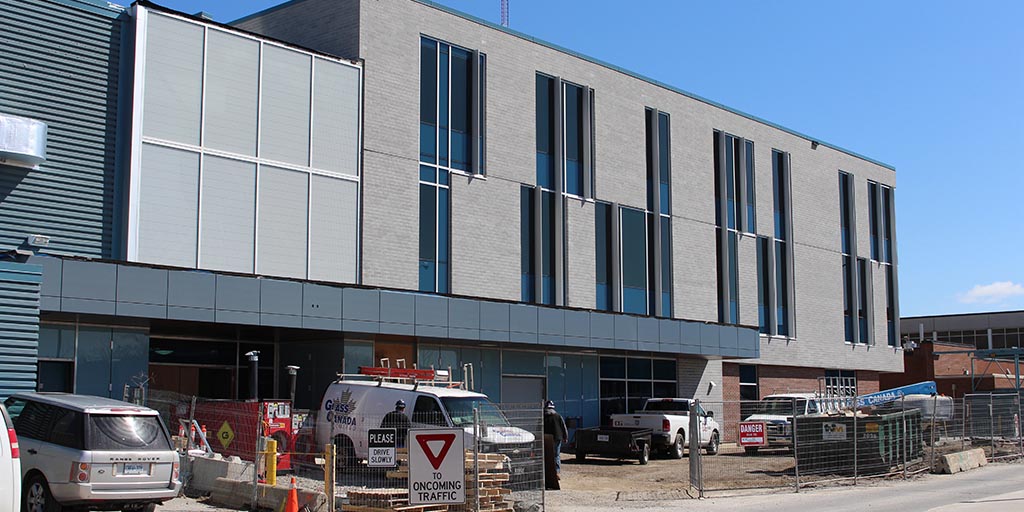Is Fanshawe doing its part to remain eco-friendly?
 CREDIT: JESSICA THOMPSON
CREDIT: JESSICA THOMPSONThe new Wellness and Fitness Centre is just one of Fanshawe's initiatives to be more sustainable. The new centre will include a green roof, self-tinting and fritted windows, low-flow toilets and occupancy sensor lighting among other things.
Sustainability has long been a priority for Fanshawe, a move reflected by its decision to join the Association for the Advancement of Sustainability in Higher Education (AASHE) in 2012. Fanshawe has taken on many initiatives since then and scored 50.82 points on AASHE's latest Sustainability Tracking, Assessment and Rating System (STARS). For perspective, 40 points is the benchmark for silver and 60 points would have elevated Fanshawe to a gold standing.
Since 2005, Fanshawe has reduced its carbon dioxide emissions by 5,500 tonnes. This is important because carbon dioxide is one of the largest contributing greenhouse gasses on the planet. It may not seem like a large amount, but that's approximately how much 1,000 cars or small trucks would generate in a year. The energy conservation initiatives have resulted in a 32 per cent decrease in overall energy usage and a 16 per cent decrease in energy cost intensity.
Fanshawe's sustainability programs haven't just been helping the environment, they've helped the students as well. With $3.9 million being saved in energy cost avoidance that has allowed budgets to be better spent on improving both equipment and curriculums.
The college recently completed a comprehensive energy audit of all its facilities which assessed just over two million square feet of property at 24 buildings located in London, St. Thomas, Simcoe and Woodstock.
The results of this extensive energy audit have provided an excellent insight into the progress of Fanshawe's five-year Energy Conservation and Demand Management Plan. The results showed that Fanshawe is nearly on schedule with its 2019 goals, displaying a 40 per cent energy usage reduction, a 25 per cent natural gas consumption reduction and a carbon production reduction of 232 tonnes in the first two years of the plan.
While there is a large focus on improving the existing infrastructure around campus, it's also important that the new buildings are built with sustainability in mind. The acting executive director of Facilities Management and Community Safety, Sean Harrington spoke of the initiatives being implemented for the new Wellness Centre that began construction in late 2015. The building will include a green roof, self-tinting and fritted windows, low-flow toilets and occupancy sensor lighting among other things. The initiatives will allow the building to remain five per cent below the 2019 energy targets. In addition to this, the downtown campus energy model is sitting 12 per cent below Fanshawe's energy goals, boasting similar eco-friendly features to the Wellness Centre.
Fanshawe isn't just improving campus facilities. Tom Davis, a building technologies professor at Fanshawe since 2008, has been leading a net-zero initiative focused on bringing renewable energy to Fanshawe residences. Davis has led students in competitions similar to this in the past and seeks to expand on the project by converting the 68 student townhomes in Kestrel Court.
This isn't the only sustainability project that has involved Fanshawe students. The horticulture program has been using Fanshawe as a living lab for years, beautifying the campus and making it more eco-friendly. The downtown campus will feature planters on the roof for cultivating vegetables and herbs to be used in the culinary program. Students in residences are invited each year to participate in an energy reduction competition. Lastly, media students were involved in designing the recycling receptacle wraps, which have helped divert trash from being thrown into waste bins when it could be recycled instead. The wraps were an important initiative for the college because recyclable materials are much more versatile when they are not cross contaminated with other kinds of trash. The few seconds spent deciding where to put that Subway cup can have drastic results.
In the future, the sustainability department wishes to become more involved with the student community through initiatives likes these and through further workshops. Fanshawe hosts “lunch and learn” sessions whereby venders throughout London teach students in a drop-in setting. Sessions have included everything from MEC bike tune ups to DIY soap seminars. There is also a tree planting program run in a similar fashion and the college has also started a bike share program. Fanshawe has come a long way since 2012, but there is still much to do. We need to stop thinking of things in isolation. Every project is interconnected and the sustainability department can't do it all by themselves. Everyone at Fanshawe needs to take the future into their hands and be conscious of their own impact on the environment. The department will be working closely with Fanshawe's student council this year to try and further integrate the students into eco-friendly campaigns around the campus.














